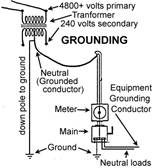Electric Grounding
Electric Grounding in Power Distribution Systems
Required for Maximum Operating Uptime
Reading Electric, a leading supplier of electro-mechanical equipment, services, and problem solver for Industrial and Commercial customers for over 50 years provides technical information to the Region’s Residential, Commercial and Industrial Community. This Bulletin provides information on the importance of a good solidly grounded system in Electrical Power Distribution.
 The NEC is pretty clear about the definition of an electrical ground: a conducting connection, whether intentional or accidental, between an electrical circuit or equipment and the earth or to some conducting body that serves in place of the earth. However, when you begin to design an electric power system, you discover that the word “ground” has a few modifiers that describe the type of ground, such as:
The NEC is pretty clear about the definition of an electrical ground: a conducting connection, whether intentional or accidental, between an electrical circuit or equipment and the earth or to some conducting body that serves in place of the earth. However, when you begin to design an electric power system, you discover that the word “ground” has a few modifiers that describe the type of ground, such as:
- Solidly grounded
- Un-grounded
- Resistance ground
- Reactance ground
The most commonly used grounding configuration for industrial, commercial and institutional power distribution systems is the solidly grounded system. Solidly grounded means connected to ground without inserting any resistor or impedance device. NEC defines when an AC power distribution system shall be grounded. In general, with few exceptions, systems that operate between 50 and 1000 volts AC with line to ground voltages of less than 150 volts and/or systems with line to neutral loads are required to be grounded. Systems 1000 volts AC or greater are permitted to be grounded unless they supply mobile or portable equipment then the mobile / portable equipment shall be grounded.
The 150 volt line-ground threshold that requires a system to be solidly grounded is based on laboratory experiments and case studies. If there is less than 150 volts across an arcing gap, the arc rarely can sustain itself. By having a solidly grounded system, there is a greater likelihood of developing sufficient short circuit current so an over-current device would trip the faulted circuit off line. The definition of ‘solidly grounded’ refers to a connection to earth, or ground, and to the word “impedance”. Impedance can be comprised of resistance, inductance and capacitance and limits current flow based on the total magnitude of the impedance measured in Ohms. The main goal of solidly grounding a power system is to provide a low-impedance return path for short circuit current during a line to ground fault. This helps produce a current with a large enough magnitude to enable protective devices to quickly clear the fault. Grounding is also used to stabilize the line to ground voltage during normal operations, and it limits voltage during abnormal surges such as lightning or accidental contact with higher voltage lines.
The NEC contains specific articles that dictate when you shall ground, when you shall not ground, and when you are permitted – but not required – to ground. These code requirements are based on various factors such as whether or not there are connected phase to neutral loads, whether only qualified persons service the installation, and operating voltage levels. All of these goals help to improve safety and minimize damage. It is important to note that just meeting the NEC requirement (25 ohms) for grounding does not ensure that the resistance level is low enough to guarantee the correct operation of Sensitive Electronics; TVSS devices and any other devices that use a reference to ground. Many applications require less than 5 ohms, and some are as low as 1 ohm. Under all circumstances “the lower the resistance the better” when dealing with sensitive equipment. However, not all power systems are solidly grounded. Depending on the NEC requirements for a given system, there may be a choice between types of grounding; so consideration must be given to the advantages and disadvantages of each. Whether the choice is solidly grounded, ungrounded or impedance grounded, the type of grounding used will affect many variables. The single biggest impact is on the magnitude of current that could flow due to a ground fault and the possible damage that the current could create. (Information contributed by the NEC Digest)
Contact Us Today for electrical equipment efficiency solutions and an opportunity to let Reading Electric’s over 50 years of expertise serve you.

Recent Comments